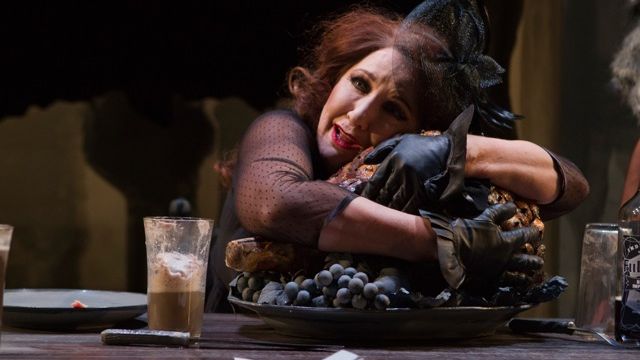The Ham Funeral
Patrick White is the only Australian writer to have been awarded the Nobel Prize for Literature, which he was given in recognition of his epic and psychological narrative art. He wrote The Ham Funeral in 1947, but had to wait 14 years to see it produced.
White has quite popularly developed themes of loneliness, the basic alienation of existence and the natural struggles which an individual faces to find fulfillment, in his writing. All of these themes are relevant in The Ham Funeral, and the overall feeling of the play is quite depressive and existential.
White also wrote with similar resonance in his novel The Living and the Dead where themes are contradictory and revolve around the characters being physically alive, whilst remaining emotionally dead. White gives these characteristics to the Landlord and his wife in The Ham Funeral.
 Director Adam Cook has commissioned a grotesque set, which for all intents and purposes serves the function of the play very suitably. Dividing the upstairs and the downstairs, and creating another contradiction – a paradox of a life lived freely (or is it?) but the Young Man, a poet, played by Luke Clayson, and the lives of the Landlady and her husband, Mr and Mrs Lusty, in the basement below.
Director Adam Cook has commissioned a grotesque set, which for all intents and purposes serves the function of the play very suitably. Dividing the upstairs and the downstairs, and creating another contradiction – a paradox of a life lived freely (or is it?) but the Young Man, a poet, played by Luke Clayson, and the lives of the Landlady and her husband, Mr and Mrs Lusty, in the basement below.
The poet shares his space upstairs with his alter-ego or other self, a girl played inspirationally by Lizzy Falkland. Lighting played a major role in developing the conflict between the poet and himself (the Girl). Though it was illustrative I don’t feel that it was overly satisfactory.
Most successful however is the costuming of the characters, particularly the relatives, from designer Ailsa Paterson. Dressed clownishly in greys, blacks and whites and acting all together over the top, they achieve something of an absurdist or expressionist style - characteristically common in White’s work, where non-realistic lighting, setting, language or action aided in the creation of another dimension which was designed to transcend the realism of the story.
 Luke Clayson plays the Young Man very well; his inner conflict is clear and his energy suitable. The soliloquies however were lacking in this same conflict and felt altogether forced.
Luke Clayson plays the Young Man very well; his inner conflict is clear and his energy suitable. The soliloquies however were lacking in this same conflict and felt altogether forced.
As Landlady, Mrs Lusty, Amanda Muggleton has a mighty job on her hands, and performed excellently. Running the gauntlet of emotions, from loss to lust, loneliness and love, Muggleton capably delivered an engaging characterisation which was connected both to the misery of Mrs Lusty’s existence and to the comedy in White’s writing. I found this a truly exciting performance to watch.
Geoff Revell and Jacqy Phillips did well with their characters First and Second Lady, providing welcome relief from the depressive opening scene. Their characterisations were light and lighthearted. Jonathan Mill and Jonathan Elsom gave nicely rounded characterisations (no pun intended), Elsom working particularly well with his facial expressions – and Mill, offering a most vacuous performance as Mr Lusty.
White’s writing is amongst some of the best Australian literature available for dramatic production (and his books are pretty good too). I recommend seeing this show, as it is a work so rarely performed and an experience every theatre lover should appreciate.
Paul Rodda
Images (from top): Amada Muggleton; Luke Clayson and Lizzy Falkland & Luke Clayson and Amanda Muggleton. Photographer: Shane Reid.
Subscribe to our E-Newsletter, buy our latest print edition or find a Performing Arts book at Book Nook.

